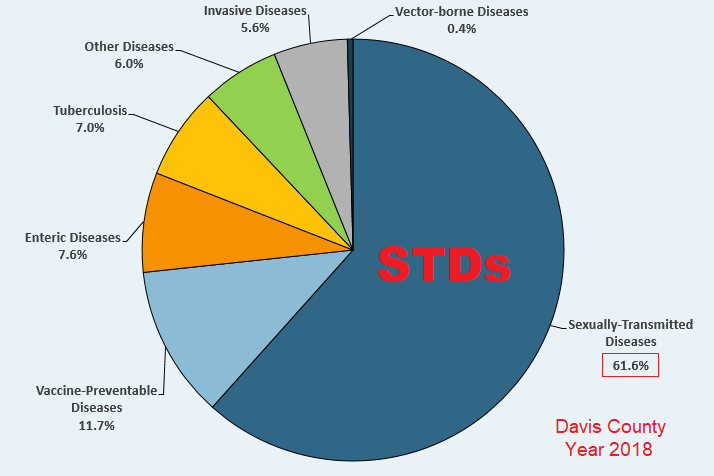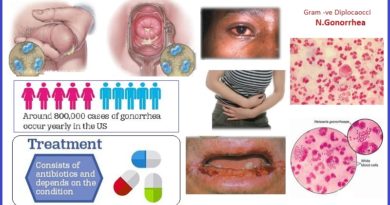Sexually Transmitted Diseases (STDs)
About Sexually Transmitted Diseases
Sexually transmitted diseases (STDs) — or sexually transmitted infections (STIs), are a group of infectious diseases that are transmitted primarily from an infected person to a healthy person through sexual intercourse. But some of them can be transmitted through blood or other body fluids, such as semen, vaginal secretions or other body secretions. Some of these diseases can be transmitted just by contact with the skin of an infected person. Also, from the infected mother to her child during pregnancy and childbirth. of all, sex is the most common means of transmission.
Sexually transmitted pathogens can be bacterial infections, viruses, or parasites. Sometimes STIs may not cause symptoms, so people who are infected can pass the infection on to others. Some of them are very similar in symptoms and are hard to distinguish.
Although it is impossible to be 100% certain about not contracting one of the STDs at some point, preventive measures must be taken to help you reduce the chances of having an STD. The basic recommendations include having safe relations, using condoms and having regular STDs testing.
Prevalence of Sexually Transmitted Diseases
- STDs are more common than you, (and many others), believe, particularly in young people as official reports show. Even though, many case are un-reported and undiagnosed.
In 2017, there were 2.3 million cases of chlamydia, gonorrhea, and syphilis cases in the United States. Therefore, they increased about 10 percent over 2016 year. Since 2003, syphilis is more about 76%, and gonorrhea is up 67 percent. - More than 1 million sexually transmitted infections (STIs) are acquired every day worldwide, the majority of which are asymptomatic.
- Each year there are an estimated 374 million new infections with: chlamydia, gonorrhea, syphilis and trichomoniasis.
- More than 500 million people 15–49 years are estimated to have a genital infection with herpes simplex virus (HSV or herpes).
- Age: The number of people suffering from sexually transmitted diseases (STDs) is growing each year. Research suggests that young people aged 15-24 are about 50% of new STD cases.
- Example of STDs prevalence: In 2018 the average rate of STDs in Davis County, (It is Utah’s smallest county in USA), was 410.8 cases per 100,000 residents. Chlamydia was the most commonly reported sexually transmitted disease there, with 1,158 cases, followed by gonorrhea with 223 cases.

Why of STDs are so common?
- Lack of gender equity
- Poverty and commercial sex
- Disruptions to traditional family life
- Inadequate health services
- Legal, cultural and religious obstacles to condom promotion and use
Why Are So Many Teens Getting STDs?
According to research and studies records, rates of sexually transmitted diseases are on rise, especially among teenagers. Teens have the highest rate of acquiring sexually transmitted infections. Why? That was, also, featured in a symposium organized by New York City STD Prevention Training Center, one of the eight Centers for Disease Control and Prevention STD Prevention Training Centers in US. About 170 experts attended the event. Drugs play an important role for increasing rates of STDs.
Most Common STDs list
- Bacterial Vaginosis
- Balanitis
- Chancroid
- Chlamydia
- Crabs (Pubic Lice)
- Cytomegalovirus (CMV)
- Gonorrhea
- Hepatitis
- HIV/AIDS
- Human Papillomavirus and Genital Warts
- Lymphogranuloma Venereum
- Molluscum Contagiosum
- Mononucleosis (Mono)
- Mycoplasma
- Nongonococcal urethritis
- Pelvic Inflammatory Disease
- Scabies
- Syphilis
- Trichomoniasis
- Vaginal Yeast Infection
- Yeast Infection in Men
Symptoms of sexually transmitted diseases
Each sexually transmitted disease has its own symptoms, which may appear soon after infection, or do not appear until later after years. Some cases show no symptoms at all. Symptoms may be local symptoms that appear around the sexual organs, or general symptoms.
First – local symptoms
- Sores or blisters on the genitals, rectal area or mouth.
- Burning during urination
- Discharge from the penis that may be clear or cloudy, with or without color.
- Vaginal discharge in women that is abnormal in quantity or has bad smell
- unusual vaginal bleeding
- Pain during intercourse
Second – general symptoms
- Inflammation of the lymph nodes, especially in the inguinal region, that may spread.
- Lower abdominal pain.
- Fever.
- Rash on the trunk, hands, or feet.
Diagnosis of Sexually Transmitted Diseases
Early and rapid diagnosis of STDs increases the chance to control and cure the disease. STDs, such as gonorrhea, syphilis, chlamydia, genital herpes, and human papillomavirus (HPV), can lead to long-term complications, if not diagnosed early and treated properly. Some of the complications include blindness, bone deformities, brain damage, cancer, heart disease, infertility, birth defects, mental retardation, and even death.
STDs can be diagnosed by laboratory tests
- Blood tests: Blood tests can be used to diagnose and confirm the diagnosis of HIV or syphilis.
- Urine samples: Some STIs can be confirmed with a urine sample like gonorrhea.
- Fluid samples from sores: If you have open genital sores, fluid and samples from the sores can be tested to diagnose the cause of infection.
SUMMARY
Sexually transmitted diseases are caused by a variety of pathogens, and present with different symptoms; from mile one to severe diseases. Some may end into death. If you suspect to be exposed to infection, you have to do testing to reach a correct diagnosis of the infection as early as possible and start treatment as soon as possible.
SOURCES:
- https://www.std-gov.org/stds/std_list.htm
- https://www.who.int/news-room/fact-sheets/detail/sexually-transmitted-infections-(stis)
- https://www.mayoclinic.org/diseases-conditions/
- Sexually Transmitted Diseases (STDs) Diagnosis
- Prevalence – PubMed (nih.gov)
- Prevalence – International Journal of Sexual Health: Vol 22, No 4 (tandfonline.com)
- STDs Highlights (daviscountyutah.gov)




